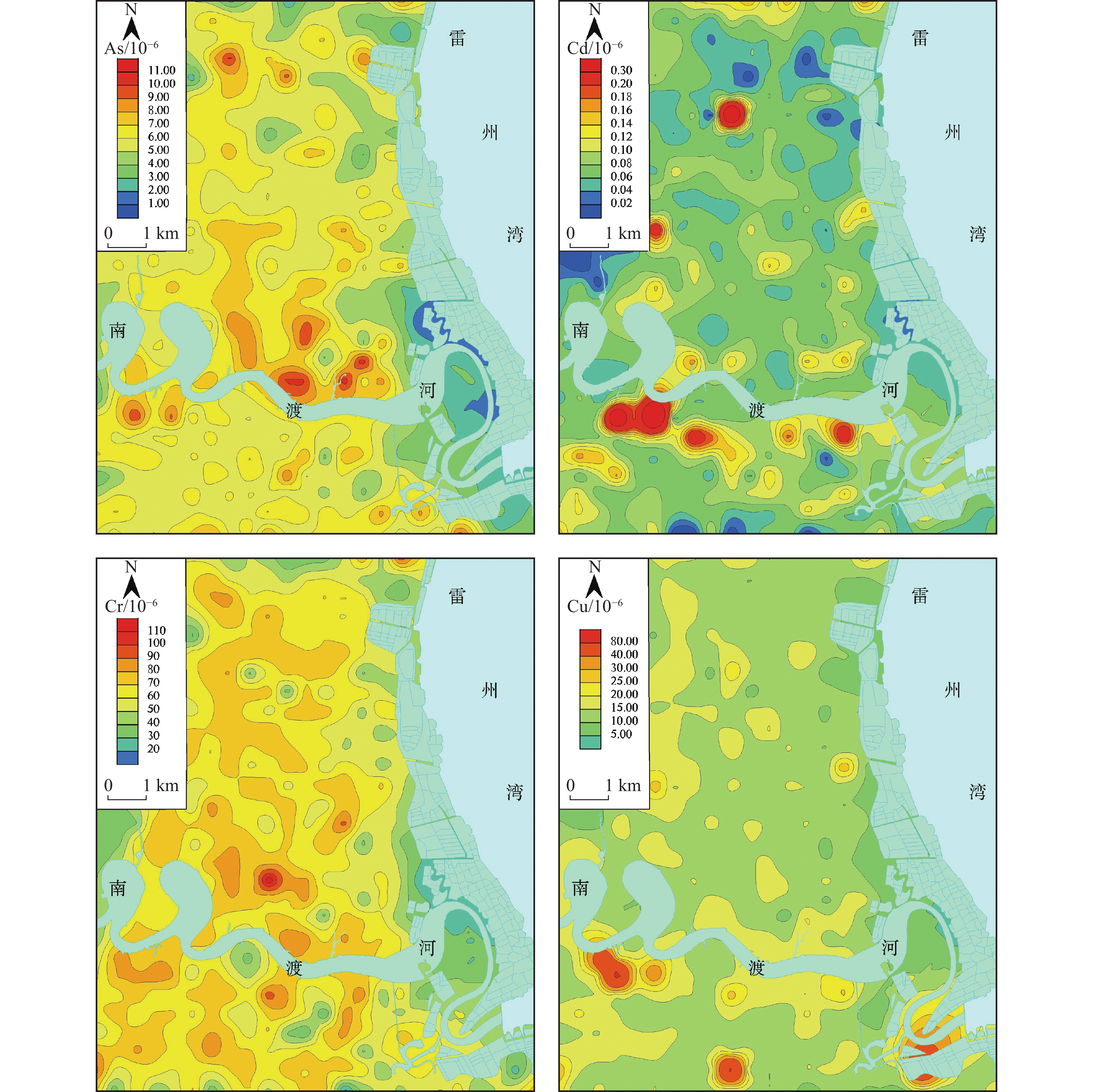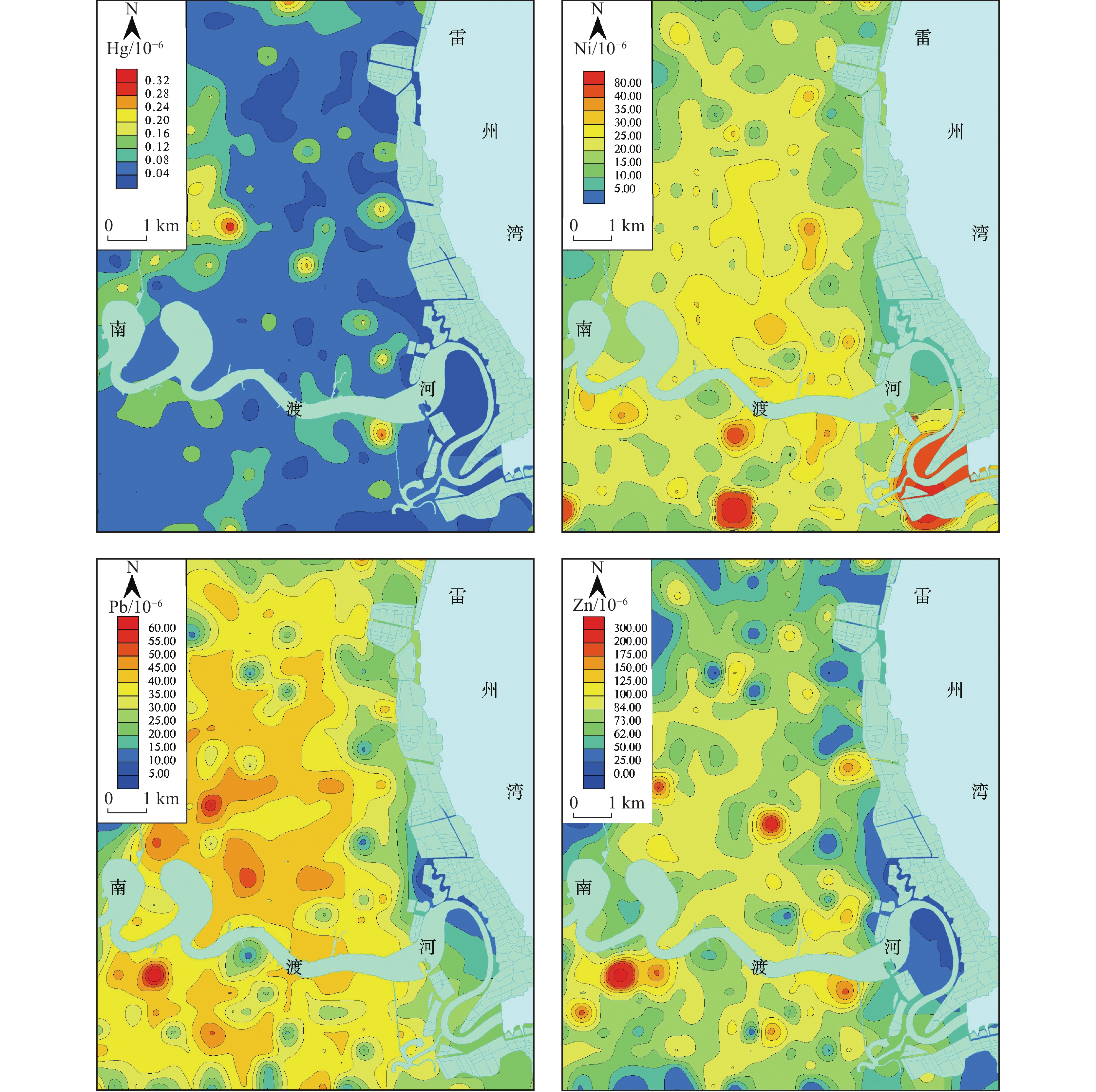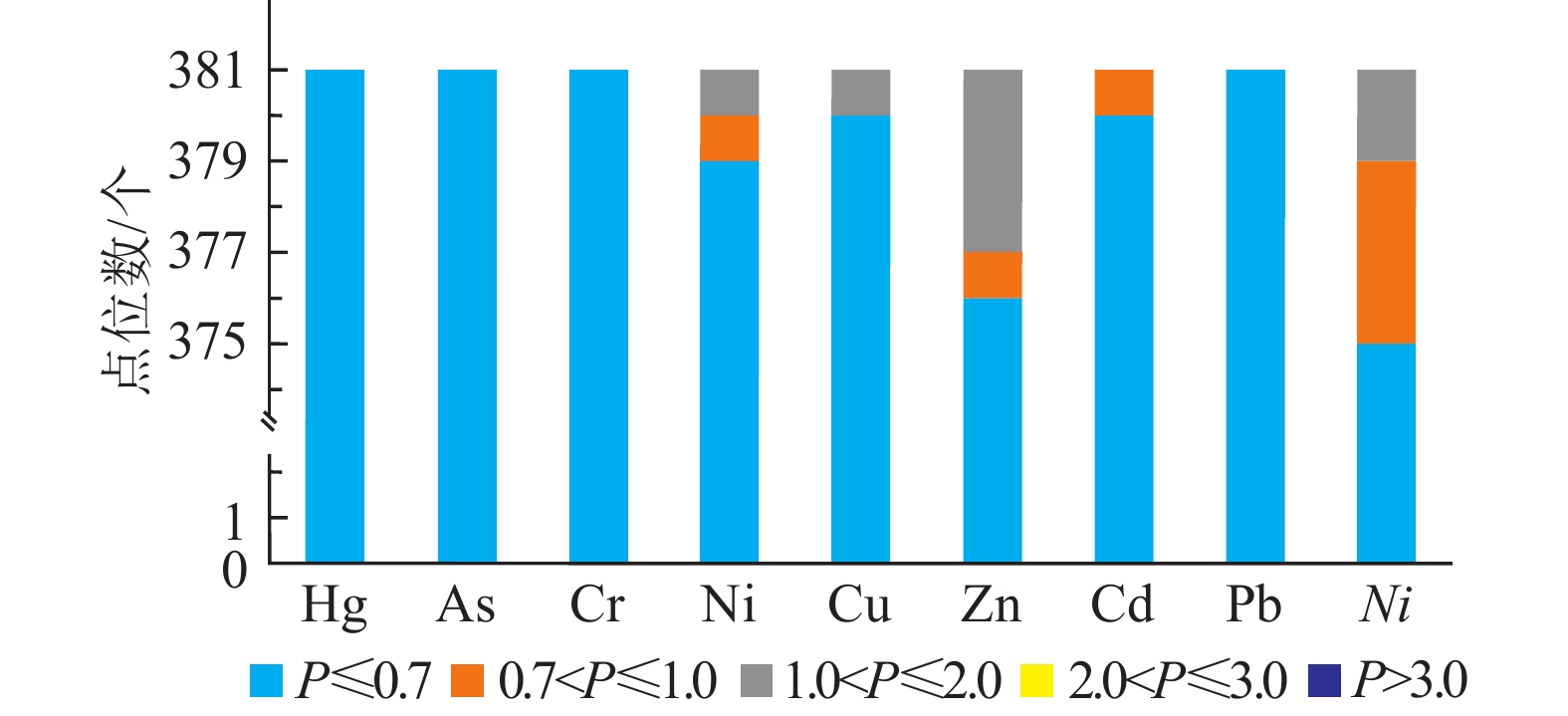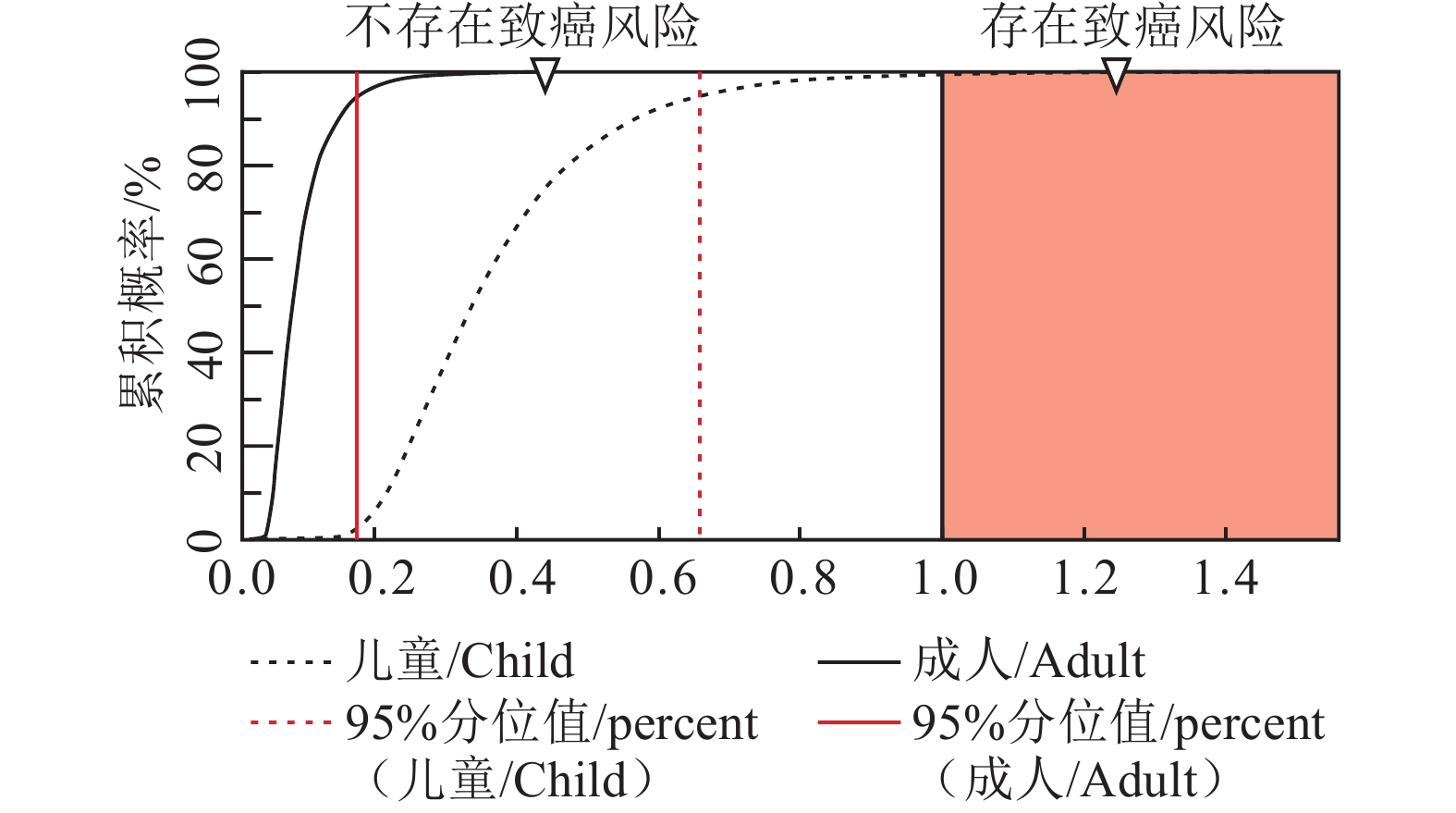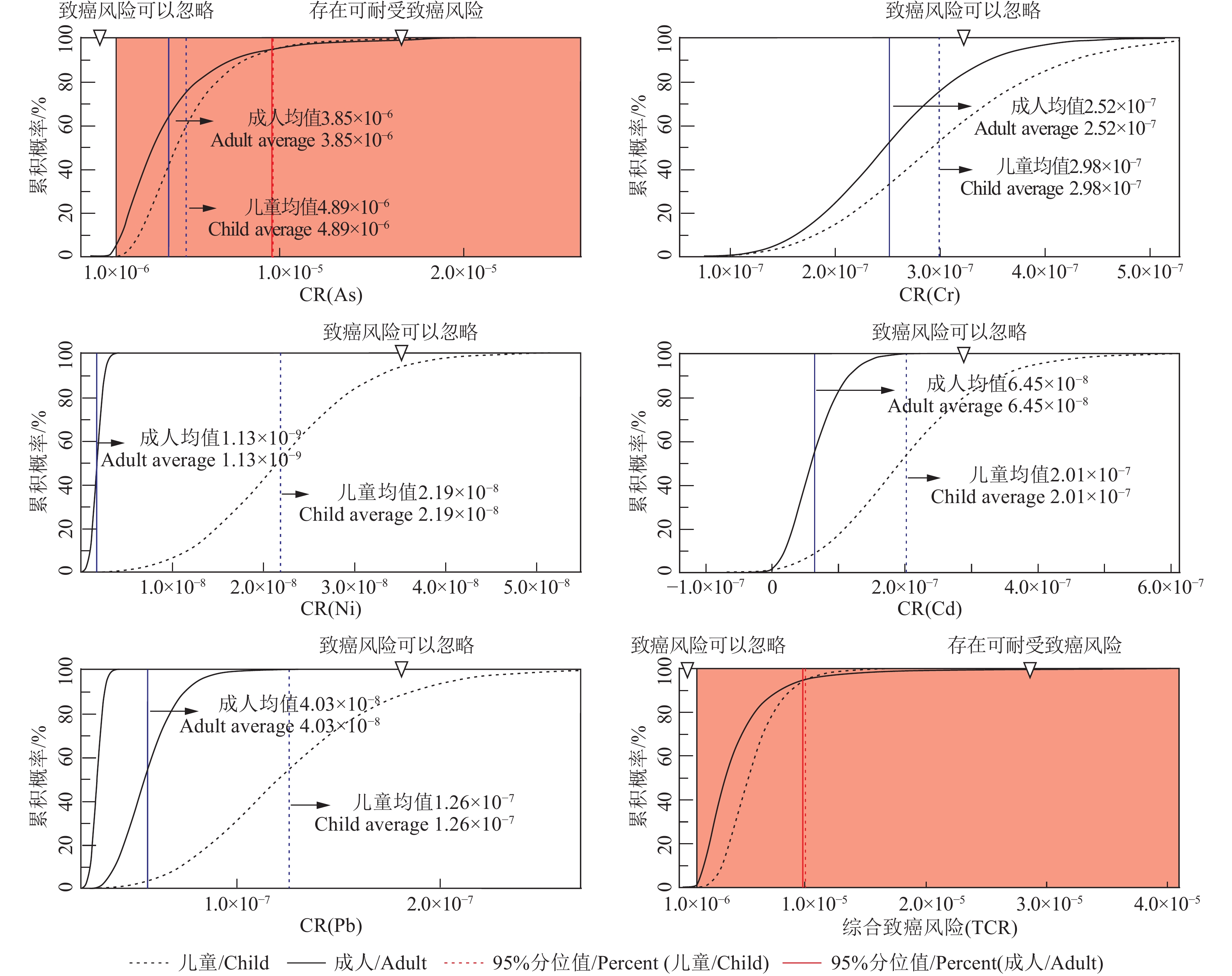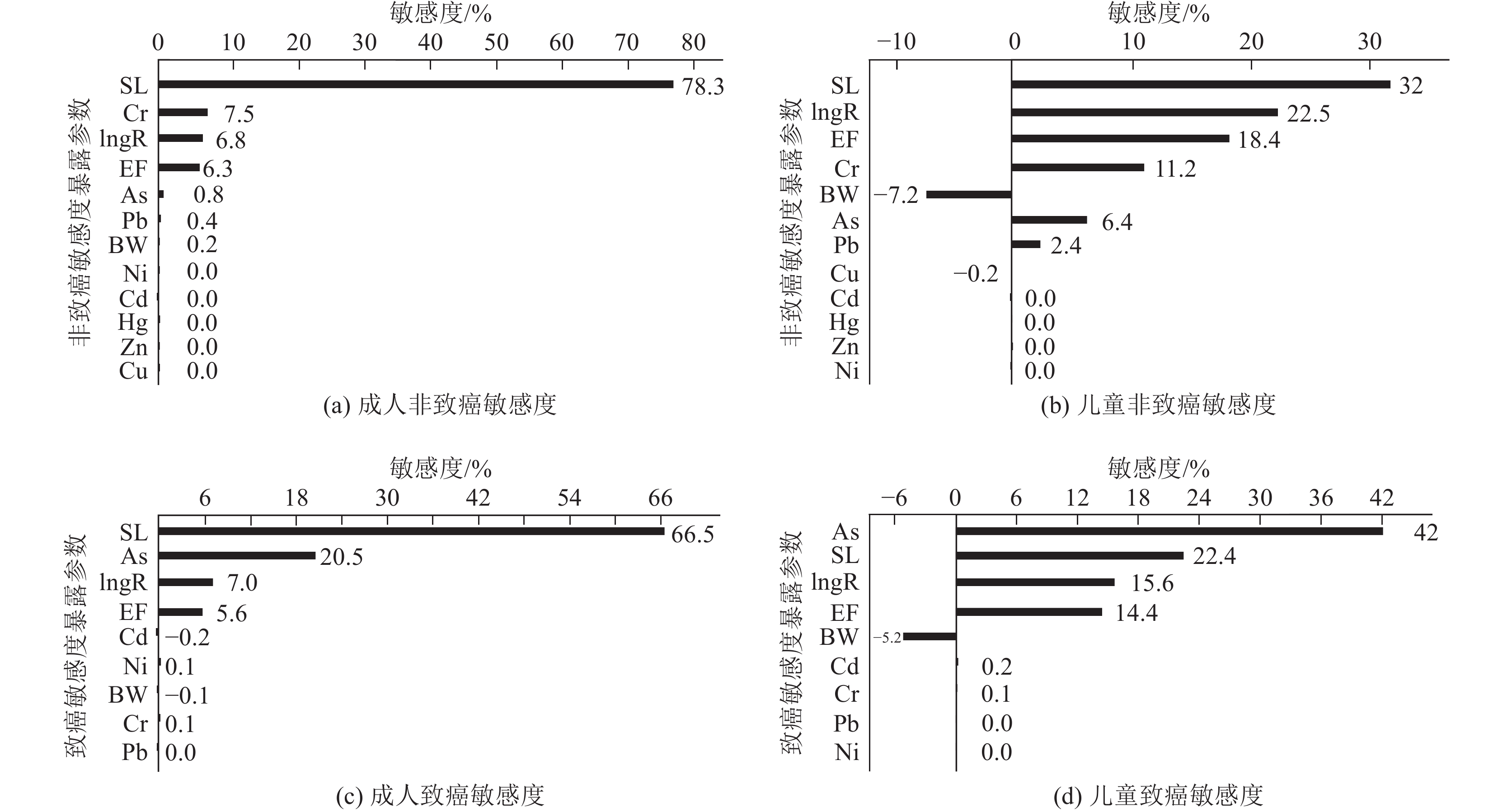Spatial distribution characteristic, source analysis and health risk assessment of the soil heavy metals in the eastern of Leizhou, Guangdong Province
-
摘要:研究目的
以雷州市东部为研究区,研究土壤重金属含量及空间分布特征,剖析重金属来源,评价重金属污染程度及人体的健康风险评价。
研究方法采集381个点位的表层土壤样,分析测试土壤重金属元素As、Cd、Cr、Cu、Hg、Ni、Pb和Zn,应用GIS软件分析重金属元素空间分布特征,运用单因子污染指数、内梅罗综合污染指数开展土壤重金属污染程度评价,采用蒙特卡洛健康风险模型评估人体健康风险。
研究结果(1)As、Cd、Cr、Cu、Hg、Ni、Pb、Zn在土壤中的平均值依次为5.85×10−6、0.079×10−6、64.03×10−6、14.11×10−6、0.07×10−6、21.23×10−6、35.38×10−6、76.45×10−6,其中Cd、Cr、Ni和Zn超过广东省土壤背景值,表明这四种元素在土壤中呈相对富集。(2)单因子污染指数和内梅罗综合污染指数显示研究区土壤质量总体较好,以清洁状态和尚清洁状态为主,仅有个别点位存在轻度污染。(3)重金属除了地质背景来源,还与交通源、农业源和工业源有关。(4)健康风险评价表明,土壤重金属对成人和儿童的非致癌健康风险可以忽略,但对成人和儿童存在可耐受致癌健康风险,最主要的致癌因素为重金属元素As;敏感性分析表明非致癌风险中皮肤黏着系数(SL)是影响非致癌风险的首要因素,致癌风险中SL和As分别是影响成人和儿童致癌的首要因素;致癌途径主要是通过皮肤暴露和手−口暴露途径进入人体。
结论雷州市东部土壤重金属污染程度较低,整体呈轻微生态风险,但Hg和Cd应引起足够的重视;As是影响人体健康的主要致癌因素,应加强对As的污染防控。
创新点:采用单因子污染指数法、内梅罗综合污染指数法研究了雷州市水稻主产区的土壤重金属污染情况,分析了重金属来源,并采用蒙特卡洛法健康风险评估模型人体的健康风险评估。
Abstract:This paper is the result of environmental geological survey engineering.
ObjectiveTaking the eastern part of Leizhou as research area, this paper studies the concentration and spatial distribution characteristics of heavy metals in soil, analyzes the sources of heavy metals, evaluates the degree of heavy metal pollution, and assess the health risks to human health.
MethodsA total of 381 soil samples are collected to measure the concentration of heavy metal elements such as As, Cd, Cr, Cu, Hg, Ni, Pb and Zn. GIS technique is used to analyze the spatial distribution characteristics of soil heavy metals; the single factor pollution index and Nemerow comprehensive pollution index methods are used to evaluate the degree of soil heavy metals pollution, and Monte Carlo health risk model is used to assess human health risks.
Results(1) The average concentration values of As, Cd, Cr, Cu, Hg, Ni, Pb and Zn in the soil are 5.85×10−6, 0.079×10−6, 64.03×10−6, 14.11×10−6, 0.07×10−6, 21.23×10−6, 35.38×10−6, 76.45×10−6, respectively. Among them, the average concentration values of Cd, Cr, Ni and Zn in the surface soils exceed the background values of soils in Guangdong Province, which indicates that these four heavy metal elements in the soil are relatively enriched. (2) The single factor pollution index and Nemerow comprehensive pollution index show that the soil is "clean" in the study area, with only a few points being polluted slightly. (3) In addition to geological background sources, heavy metals in surface soil also come from sources such as transportation, agriculture, and industry. (4) The health risk assessment of heavy metals shows that the non−carcinogenic health risks of children and adults could be ignored, but there are tolerable carcinogenic risks for both children and adults. The major carcinogenic factor is As. Sensitivity analysis indicates that the SL (Skin adhesion coefficient) is the primary factor affecting non−carcinogenic health risk, while the SL and As are the primary factors affecting carcinogenic health risk in adults and children, respectively. The main exposure routes of carcinogenicity are skin exposure and hand−oral exposure.
ConclusionsThe pollution of soil heavy metals in the eastern of Leizhou is relatively low, and the ecological risk is low on the whole. However, Hg and Cd should be given sufficient attention. As is the main carcinogenic factor affecting human health, and pollution prevention and control of As should be strengthened.
Highlights:The single factor pollution index, Nemero comprehensive pollution index were used to study the soil heavy metal pollution in the main rice producing area of Leizhou and analyze the sources of heavy metals. We use the Monte Carlo health risk assessment model to assess the human health risk.
-
-
表 1 单因子及内梅罗综合污染等级划分方案
Table 1 Pollution index grade of single and comprehensive Nemerow
等级 单因子污染指数 污染程度 综合污染指数 污染程度 污染水平 1 Pi≤0.7 无污染 Ni≤0.7 无污染 清洁 2 0.7<Pi≤1.0 警戒级 0.7<Ni≤1.0 警戒级 尚清洁 3 1.0<Pi≤2.0 轻度污染 1.0<Ni≤2.0 轻度污染 开始受到污染 4 2.0<Pi≤3.0 中度污染 2.0<Ni≤3.0 中度污染 受到中度污染 5 Pi>3.0 重度污染 Ni>3.0 重度污染 受到重度污染 表 2 不同暴露途径下蒙特卡洛土壤重金属健康风险模型参数值
Table 2 Parameter values of health risk assessment model under the different exposure pathways via Monte Carlo simulation
暴露参数 含义 单位 概率分布 取值 成人 儿童 lngR 土壤摄入量 mg/d 三角分布 30(4、52) 103(66、161) lnhR 呼吸摄入量 m3/d 点分布 19 8.6 EF 暴露频率 d/a 三角分布 345(180、365) ED 暴露年限 a 点分布 24 6 BW 体重 kg 对数分布 57.03±1.18 16.68±1.48 AT 平均暴露时间 d 点分布 365×ED(非致癌)365×76(致癌) PEF 颗粒物释放因子 m3/kg 点分布 1.36×109 SA 皮肤暴露面积 m2 点分布 0.54 0.23 SL 皮肤黏着系数 mg/(cm2·d) 对数正态 0.49±0.54 0.65±1.2 ABS 皮肤吸收因子 无量纲 点分布 0.001(非致癌)0.01(致癌) 注:三角分布:最可能值(最小值、最大值);对数分布:平均值±标准差。 表 3 不同暴露途径下土壤重金属的斜率因子和参考剂量
Table 3 Slope factor and reference dose of soil heavy metals from different exposure pathways
元素 RfD/(mg/(kg·d)) SF/(mg/(kg·d)) 手−口摄入 呼吸摄入 皮肤摄入 手−口摄入 呼吸摄入 皮肤摄入 As 3.00×10−4 1.23×10−4 1.23×10−4 1.50 1.51×101 3.66 Cd 1.00×10−3 1.00×10−5 1.00×10−5 6.10 6.3 − Cr 3.00×10−3 2.86×10−5 6.00×10−5 8.50×10−3 4.20×101 − Cu 4.00×10−2 4.02×10−2 1.20×10−2 − − − Hg 3.00×10−4 8.57×10−5 2.10×10−5 − − − Ni 2.00×10−2 2.06×10−2 5.40×10−3 − 8.40×10−1 − Pb 3.50×10−3 3.52×10−3 5.25×10−4 8.50×10−3 − − Zn 3.00×10−1 6.00×10−2 3.00×10−1 − − − 注:“−”表示为无数据;RfD和SF参考值详见文献(马杰等,2023;李剑锋和冯李霄,2023)。 表 4 土壤重金属含量测量结果(10−6)
Table 4 Concentration of heavy metals in the soil of study area (10−6)
元素 最大值 最小值 平均值 标准偏差 变异系数% 背景值 风险筛选值 As 11.60 1.11 5.85 1.58 27 8.9 30 Cd 0.282 0.015 0.079 0.036 45 0.06 0.4 Cr 122.00 13.90 64.03 14.75 23 50.5 250 Cu 78.40 5.08 14.11 4.79 34 17 50 Hg 0.351 0.003 0.07 0.05 68 0.08 0.5 Ni 73.00 4.21 21.23 7.05 33 14.4 70 Pb 63.30 5.47 35.58 9.04 25 36 100 Zn 284.00 12.60 76.45 27.20 36 47.3 200 注:背景值为广东省土壤环境背景值,风险筛选值为《土壤环境质量标准》(GB 15618—2018)水田重金属含量(5.5<pH≤6.5)。 表 5 土壤重金属含量相关性分析(n=381)
Table 5 Correlation analysis of soil heavy metals concentration (n=381)
As Cd Cr Cu Hg Ni Pb Zn As 1 Cd 0.000 1 Cr 0.494** 0.219** 1 Cu 0.401** 0.430** 0.606** 1 Hg −0.004 0.276** 0.082 0.401** 1 Ni 0.480** 0.275** 0.800** 0.635** 0.008 1 Pb 0.406** 0.202** 0.711** 0.486** 0.261** 0.648** 1 Zn 0.354** 0.480** 0.630** 0.701** 0.281** 0.754** 0.645** 1 注:**表示在0.01 水平(双侧)上显著相关。 表 6 土壤重金属含量因子分析
Table 6 Factor analysis of soil heavy metals concentration
重金属元素 旋转前因子 旋转后因子 F1 F2 F3 F1 F2 F3 As 0.565 −0.473 0.293 0.748 −0.265 0.018 Cd 0.454 0.613 −0.517 0.071 0.908 0.141 Cr 0.853 −0.275 −0.020 0.877 0.185 −0.009 Cu 0.821 0.229 0.058 0.640 0.425 0.376 Hg 0.309 0.720 0.595 0.039 0.148 0.972 Ni 0.872 −0.259 −0.194 0.864 0.323 −0.117 Pb 0.797 −0.111 0.192 0.783 0.116 0.240 Zn 0.876 0.145 −0.147 0.698 0.535 0.186 方差贡献 4.186 1.347 0.807 3.591 1.536 1.212 贡献率/% 52.319 16.843 10.088 44.891 19.203 15.156 累积贡献率/% 52.319 69.162 79.250 44.891 64.094 79.250 注:旋转在4次迭代后收敛。 表 7 土壤重金属非致癌健康风险评估
Table 7 Non−carcinogenic health risk indices of soil heavy metals
重金属元素 HQmax HQmin HQadv 成人 儿童 成人 儿童 成人 儿童 As 2.34×10−2 2.34×10−1 2.24×10−3 2.24×10−2 1.18×10−2 1.18×10−1 Cd 1.38×10−3 4.05×10−3 7.36×10−5 2.15×10−4 3.87×10−4 1.13×10−3 Cr 1.10×10−1 4.11×10−1 1.26×10−2 4.68×10−2 5.79×10−2 2.16×10−1 Cu 1.26×10−3 1.20×10−2 8.17×10−5 7.77×10−4 2.27×10−4 2.16×10−3 Hg 1.32×10−3 8.25×10−3 1.24×10−5 7.75×10−5 2.58×10−4 1.62×10−3 Ni 2.41×10−3 2.25×10−2 1.39×10−4 1.29×10−3 7.00×10−4 6.53×10−3 Pb 1.43×10−2 1.16×10−1 1.23×10−3 1.00×10−2 8.03×10−3 6.51×10−2 Zn 5.13×10−4 5.61×10−3 2.28×10−5 2.49×10−4 1.38×10−4 1.51×10−3 -
[1] An Yonglong, Yin Xiulan, Li Wenjuan, Jin Aifang, Lu Qingyuan. 2023. Evaluation and source analysis of heavy metal pollution in a planting area in Wanquan District, Zhangjiakou City[J]. Environmental Science, 44(6): 3544−3561 (in Chinese with English abstract).
[2] Borůvka L, Vacek O, Jehlička J. 2005. Principal component analysis as a tool to indicate the origin of potentially toxic elements in soils[J]. Geoderma, 128(3/4): 289−300.
[3] Chen Bishan, Cai Yueyan, Ye Linhai, Chen Jieru, Zhou Shurou, Ying Xiaoqin. 2022a. Characteristics of heavy metal content and ecological risk assessment of vegetable soil in Zhanjiang City[J]. Guangdong Agricultural Sciences, 49(4): 46−53 (in Chinese with English abstract).
[4] Chen Bishan, Yang Manting, Mo Huaping, Ye Jian, Xu Chaodie, Li Min, Song Xiuli. 2022b. Soil–rice system characteristics and migration regularity of heavy metal content in Leizhou Peninsula[J]. Journal of Southern Agriculture, 53(1): 68−77 (in Chinese with English abstract).
[5] Chen Bishan, Zheng Kanghui, Wang Jing, Ye Linhai, Song Junxia. 2022c. Content characteristics and health risk analysis of mercury in soil–crop system in Leizhou Peninsula[J]. Ecology and Environmental Sciences, 31(3): 572−582 (in Chinese with English abstract).
[6] Chen Danqing, Xie Zhiyi, Zhang Yajing, Luo Xiaoling, Guo Qingrong, Yang Jianjun, Liang Yaojie. 2016. Source apportionment of soil heavy metals in Guangzhou based on the PCA/APCS model and geostatistics[J]. Ecology and Environmental Sciences, 25(6): 1014−1022 (in Chinese with English abstract).
[7] Chen Yali, Weng Liping, Ma Jie, Wu Xiaojuan, Li Yongtao. 2019. Review on the last ten years of research on source identification of heavy metal pollution in soils[J]. Journal of Agro–Environment Science, 38(10): 2219−2238 (in Chinese with English abstract).
[8] Chen Yujia, Qu Xingchen, Zhang Bin, Li Xiantao, Zhu Guoping, Zha Tonggang. 2022. Ecological and health risk assessment of heacy metal pollution in farmland soil of Xianghe County[J]. Environmental Science, 43(12): 5728−5741 (in Chinese with English abstract).
[9] Chen Z Y, Zhao Y Y, Chen D L, Huang H T, Yu Z, Wu Y J. 2023. Ecological risk assessment and early warning of heavy metal cumulation in the soils near the Luanchuan molybdenum polymetallic mine concentration area, Henan Province, central China[J]. China Geology, 6(1): 15−26.
[10] Cui Xingtao, Luan Wenlou, Song Zefeng, Ma Yuntao. 2016. A study of the spatial distribution and source of heavy metals in urban soil in Shijiazhuang City[J]. Geology in China, 43(2): 683−690 (in Chinese with English abstract).
[11] Fang Qing, Xian Ping, Meng Zhengcheng. 2021. Environmental health risk assessment model of agricultural land based on Monte Carlo simulation and its application[J]. Environmental Engineering, 39(2): 147−152 (in Chinese with English abstract).
[12] Guan Hui, Wan Hongfu, Wang Xianmin, Yang Guoyi, Zhu Yongan. 2006. Distribution and pollution assessment of heavy metals in soil samples of Leizhou Peninsula[J]. Environmental Pollution & Control, 28(10): 757−760, 771 (in Chinese with English abstract).
[13] Hu B F, Shao S, Ni H, Fu Z Y, Hu L S, Zhou Y, Min X X, She S F, Chen S C, Huang M X, Zhou L Q, Li Y, Zhou S. 2020. Current status, spatial features, health risks, and potential driving factors of soil heavy metal pollution in China at province level[J]. Environmental Pollution, 266(3): 114961.
[14] Li Chunfang, Wang Fei, Cao Wentao, Pan Jian, Lü Jianshu, Wu Quanyuan. 2017. Source analysis, spatial distribution and pollution assessment of heavy metals in sewage irrigation area farmland soils of Longkou City[J]. Environmental Science, 38(3): 1018−1027 (in Chinese with English abstract).
[15] Li Jianfeng, Feng Lixiao. 2023. Health risk assessment of heavy metal pollution in soil of a tin mining area in Hunan Province[J]. Geology in China, 50(3): 897−910 (in Chinese with English abstract).
[16] Li Jun, Li Xu, Li Kaiming, Jiao Liang, Tai Xisheng, Zang Fei, Cao Suzhen. 2024. Characteristics and identification priority source of heavy metals pollution in farmland soils in the Yellow River Basin[J]. Environmental Science, 45(3): 1724−1738 (in Chinese with English abstract).
[17] Li Ping, Huang Yong, Lin Yun, Yuan Guoli. 2018. Distribution, source identification and risk assessment of heavy metals in topsoil of Huairou district in Beijing[J]. Geoscience, 32(1): 86−94 (in Chinese with English abstract).
[18] Li Yanhong. 2007. Review on the mechanism of carcinogenesis of arsenic[J]. Chinese Journal of Control of Endemic Diseases, 22(4): 364−267 (in Chinese with English abstract).
[19] Li X W, Ding D, Xie W Y, Zhang Y, Kong L Y, Li M, Li M, Deng S P. 2024. Risk assessment and source analysis of heavy metals in soil around an asbestos mine in an arid plateau region, China[J]. Scientific Reports, 14: 7552. doi: 10.1038/s41598-024-58117-4
[20] Luo Songying, Ke Siyin, Wang Jiaqi, Chen Dongping, Liu Nuolin. 2019. Spatial distribution and source analysis of heavy metals content in vegetable field soils in suburb of Zhanjiang[J]. Journal of Southern Agriculture, 50(8): 1709−1717 (in Chinese with English abstract).
[21] Ma Jie, She Zelei, Wang Shenglan, Deng Li, Liu Ping, Sun Jing. 2023. Health risk assessment of heavy metals in agricultural soils around the gangue heap of coal mine based on Monte Carlo simulation[J]. Environmental Science, 44(10): 5666−5678 (in Chinese with English abstract).
[22] Nemerow N L. 1974. Scientific Stream Pollution Analysis[M]. New York: McGraw–Hill Book Company.
[23] Song Wei, Chen Baiming, Liu Lin. 2013. Soil heavy metal pollution of cultivated land in China[J]. Research of Soil and Water Conservation, 20(2): 293−298 (in Chinese with English abstract).
[24] Sun C Y, Liu J S, Wang Y, Sun L Q, Yu H W. 2013. Multivariate and geostatistical analyses of the spatial distribution and sources of heavy metals in agricultural soil in Dehui, Northeast China[J]. Chemosphere, 92(5): 517−523. doi: 10.1016/j.chemosphere.2013.02.063
[25] Sun Zhijia, Li Baofei, Chen Yuhai, Yuan Qingzheng, Yan Xingguo, Zhao Mingjie. 2022. Assessment of agricultural land on soil heavy metals pollution and ecological risk in the northeast of Zhanjiang City[J]. Journal of Heibei Agricultural University, 45(1): 61−68 (in Chinese with English abstract).
[26] Tu Chunlin, Yang Kun, He Chengzhong, Zhang Liankai, Li Bo, Wei Zong, Jiang Xin, Yang Minghua. 2023. Sources and risk assessment of heavy metals in sediments of small watersheds in typical coal mining areas of Eastern Yunnan[J]. Geology in China, 50(1): 206−221 (in Chinese with English abstract).
[27] Viard B, Pihan F, Promeyrat S, Pihan J–C. 2004. Integrated assessment of heavy metal (Pb, Zn, Cd) highway pollution: Bioaccumulation in soil, Graminaceae and land snails[J]. Chemosphere, 55(10): 1349−1359. doi: 10.1016/j.chemosphere.2004.01.003
[28] Wang Jing, Wei Hen, Pan Bo. 2023. Accumulation characteristics and probabilistic risk assessment of Cd in agricultural soils across China[J]. Environment Science, 44(7): 4006−4016 (in Chinese with English abstract).
[29] Wu Jing, Dong Xinmin, Zheng Yanfang, Zhang Jiren. 2015. Recent research progress in molecular mechanisms of cadmium induced carcinogenesis[J]. Asian Journal of Ecotoxicology, 10(6): 54−61 (in Chinese with English abstract).
[30] Wu Xianye, Hua Huigong, Shen Hongyi. 2022. Discussion on the application effect of different dosages of zinc fertilizer on rice in Hepu County[J]. Bulletin of Agricultural Science and Technology, (5): 122−124 (in Chinese)
[31] Xue Qiang, Zhao Yuanyi, Zhang Jiawen, Guo Ke, Liu Jianping, Lu Lu. 2014. The risk threshold value method of soil heavy metals based on crop safety[J]. Geological Bulletin of China, 33(8): 1132−1139 (in Chinese with English abstract).
[32] Yang Guoyi, Zhang Tianbin, Wan Hongfu, Luo Wei, Gao Yuanxue. 2007. Spatial distribution and sources of heavy metal pollution of agricultural soils in the typical areas of Guangdong Province, China[J]. Soil, 39(3): 387−392 (in Chinese with English abstract).
[33] Ye Yuting, Luo Caibao, Yang Kunmei, Liu Xianlan, Niu Dongfeng. 2019. Soil heavy metal pollution and potential ecological risk assessment in Leizhou Peninsula[J]. Anhui Agricultural Science Bulletin, 25(14): 95−98 (in Chinese).
[34] Yu Tao, Jiang Tianyu, Liu Xu, Ma Xudong, Yang Zhongfang, Hou Qingye, Xia Xueqi, Li Fengyan. 2021. Research progress in current status of soil heavy metal pollution and analysis technology[J]. Geology in China, 48(2): 460−476 (in Chinese with English abstract).
[35] Zeng Qingqing, Fu Tianling, Zou Hongqin, Teng Lang, Wu Kang, Xie Ting, He Tengbing. 2021. Spatial distribution characteristics and sources of heavy metals in soil in a pepper growing area of county in Guizhou Province, China[J]. Journal of Agro–Environment Science, 40(1): 102−113 (in Chinese with English abstract).
[36] Zhao Ming. 2019. Study on the application of zinc fertilizer on rice[J]. Modern Agriculture Research, (12): 58−59 (in Chinese with English abstract).
[37] Zhang Jian, Yang Ruidong, Chen Rong, Peng Yishu. 2017. Bioconcentration of heavy metals in soil–capsicum annuum L. system in Karst areas of Guizhou Province[J]. Food Science, 38(21): 175−181 (in Chinese with English abstract).
[38] Zheng Xiaolin, Tang Chunliang, Zheng Hualiu. 2004. Analysis of heavy metal content and pollution evaluation in soil of vegetable garden in the suburbs of Zhanjiang City[J]. Journal of Agricultural Resources and Environment, (1): 33−35 (in Chinese).
[39] Zhou Yi, Hu Wenyou, Huang Biao, Ji Rongping, Liu Benle, Liu Peng, Wang Xinkai. 2020. Current status and research progress of heavy metal pollution in soils surrounding highways of China[J]. Environmental Monitoring in China, 36(5): 112−120 (in Chinese with English abstract).
[40] 安永龙, 殷秀兰, 李文娟, 金爱芳, 鲁青原. 2023. 张家口市万全区某种植区土壤重金属污染评价与来源分析[J]. 环境科学, 44(6): 3544−3561. [41] 陈碧珊, 蔡月炎, 叶林海, 陈洁茹, 周舒柔, 英晓芹. 2022a. 湛江市蔬菜地土壤重金属含量特征及生态风险评价[J]. 广东农业科学, 49(4): 46−53. [42] 陈碧珊, 杨漫婷, 莫华萍, 叶健, 徐超蝶, 李敏, 宋秀丽. 2022b. 雷州半岛土壤–水稻系统重金属含量特征及其迁移规律[J]. 南方农业学报, 53(1): 68−77. [43] 陈碧珊, 郑康慧, 王璟, 叶林海, 宋军霞. 2022c. 雷州半岛土壤–农作物汞元素含量特征与健康风险分析[J]. 生态环境学报, 31(3): 572−582. [44] 陈丹青, 谢志宜, 张雅静, 罗小玲, 郭庆荣, 杨剑军, 梁耀杰. 2016. 基于PCA/APCS和地统计学的广州市土壤重金属来源解析[J]. 生态环境学报, 25(6): 1014−1022. [45] 陈雅丽, 翁莉萍, 马杰, 武晓娟, 李永涛. 2019. 近十年中国土壤重金属污染源解析研究进展[J]. 农业环境科学学报, 38(10): 2219−2238. doi: 10.11654/jaes.2018-1449 [46] 陈瑜佳, 屈星辰, 张斌, 李现涛, 朱国平, 查同刚. 2022. 香河县农田土壤重金属污染生态与健康风险评价[J]. 环境科学, 43(12): 5728−5741. [47] 崔邢涛, 栾文楼, 宋泽峰, 马云超. 2016. 石家庄城市土壤重金属空间分布特征及源解析[J]. 中国地质, 43(2): 683−690. doi: 10.3969/j.issn.1000-3657.2016.02.027 [48] 方晴, 冼萍, 蒙政成. 2021. 基于蒙特卡罗模拟的农用地土壤健康风险评价[J]. 环境工程, 39(2): 147−152. [49] 关卉, 万洪富, 王冼民, 杨国义, 朱永安. 2006. 雷州半岛土壤重金属分布特征及其污染评价[J]. 环境污染与防治, 28(10): 757−760, 771. doi: 10.3969/j.issn.1001-3865.2006.10.011 [50] 李春芳, 王菲, 曹文涛, 潘健, 吕建树, 吴泉源. 2017. 龙口市污水灌溉区农田重金属来源、空间分布及污染评价[J]. 环境科学, 38(3): 1018−1027. [51] 李剑锋, 冯李霄. 2023. 湖南某锡矿区土壤重金属污染及健康风险评价[J]. 中国地质, 50(3): 897−910. doi: 10.12029/gc20220825003 [52] 李军, 李旭, 李开明, 焦亮, 台喜生, 臧飞, 曹素珍. 2024. 黄河流域农田土壤重金属污染特征及其有限控制源分析[J]. 环境科学, 45(3): 1724−1738. [53] 李苹, 黄勇, 林赟, 华培学, 袁国礼. 2018. 北京市怀柔区土壤重金属的分布特征、来源分析及风险评价[J]. 现代地质, 32(1): 86–94. [54] 李艳红. 2007. 砷的致癌性研究进展[J]. 中国地方病防治杂志, 22(4): 264−267. doi: 10.3969/j.issn.1001-1889.2007.04.009 [55] 罗松英, 柯思茵, 王嘉琦, 陈东平, 刘诺林. 2019. 湛江市郊蔬菜地土壤重金属空间分布特征及来源分析[J]. 南方农业学报, 50(8): 1709–1717. [56] 马杰, 佘泽蕾, 王胜蓝, 邓力, 刘萍, 孙静. 2023. 基于蒙特卡罗模拟的煤矸山周边农用地土壤重金属健康风险评估[J]. 环境科学, 44(10): 5666−5678. [57] 宋伟, 陈百明, 刘琳. 2013. 中国耕地土壤重金属污染概况[J]. 水土保持研究, 20(2): 293−298. [58] 孙志佳, 李保飞, 陈玉海, 袁庆政, 闫兴国, 赵明杰. 2022. 湛江东北部农用地土壤重金属污染及生态风险评价[J]. 河北农业大学学报, 45(1): 61–68. [59] 涂春霖, 杨坤, 和成忠, 张连凯, 李博, 魏总, 姜昕, 杨明花. 2023. 滇东典型煤矿区小流域沉积物重金属来源及风险评价[J]. 中国地质, 50(1): 206–221. [60] 王静, 魏恒, 潘波. 2023. 中国农田土壤Cd累积分布特征及概率风险评价[J]. 环境科学, 44(7): 4006−4016. [61] 吴婧, 董欣敏, 郑燕芳, 张积仁. 2015. 镉致癌的分子机制研究进展[J]. 生态毒理学报, 10(6): 54−61. [62] 吴弦业, 花会功, 沈泓毅. 2022. 锌肥不同用量在合浦县水稻上的应用效果探讨[J]. 农业科技通讯, (5): 122−124. doi: 10.3969/j.issn.1000-6400.2022.05.035 [63] 薛强, 赵元艺, 张佳文, 郭科, 柳建平, 路璐. 2014. 基于农作物使用安全的土壤重金属风险阈值[J]. 地质通报, 33(8): 1132−1139. doi: 10.3969/j.issn.1671-2552.2014.08.006 [64] 杨国义, 张天彬, 万洪富, 罗薇, 高原雪. 2007. 广东省典型区域农业土壤中重金属污染空间差异及原因分析[J]. 土壤, 39(3): 387−392. doi: 10.3321/j.issn:0253-9829.2007.03.011 [65] 叶宇婷, 罗财宝, 杨坤美, 刘显兰, 牛东风. 2019. 雷州半岛土壤重金属污染及潜在生态风险评价[J]. 安徽农学通报, 25(14): 95−98. doi: 10.3969/j.issn.1007-7731.2019.14.040 [66] 余涛, 蒋天宇, 刘旭, 马旭东, 杨忠芳, 侯青叶, 夏学齐, 李凤嫣. 2021. 土壤重金属污染现状及检测分析技术研究进展[J]. 中国地质, 48(2): 460−476. doi: 10.12029/gc20210208 [67] 曾庆庆, 付天岭, 邹洪秦, 滕浪, 吴康, 谢挺, 何腾兵. 2021. 贵州省某县辣椒种植区土壤重金属空间分布特征及来源解析[J]. 农业环境科学, 40(1): 102−113. [68] 赵明. 2019. 锌肥在水稻上的应用研究[J]. 现在农业研究, (12): 58−59. [69] 张建, 杨瑞东, 陈蓉, 彭益书. 2017. 贵州喀纳斯地区土壤–辣椒体系重金属元素的生物迁移积累特征[J]. 食品科学, 38(21): 175−181. doi: 10.7506/spkx1002-6630-201721028 [70] 郑小林, 唐纯良, 郑华柳. 2004. 湛江市郊区蔬园土壤重金属含量分析及其污染评价[J]. 农业环境与发展, (1): 33−35. [71] 周怡, 胡文友, 黄标, 纪荣平, 刘本乐, 刘鹏, 王信凯. 2020. 我国高速公路周边土壤重金属污染现状及研究进展[J]. 中国环境监测, 36(5): 112−120.



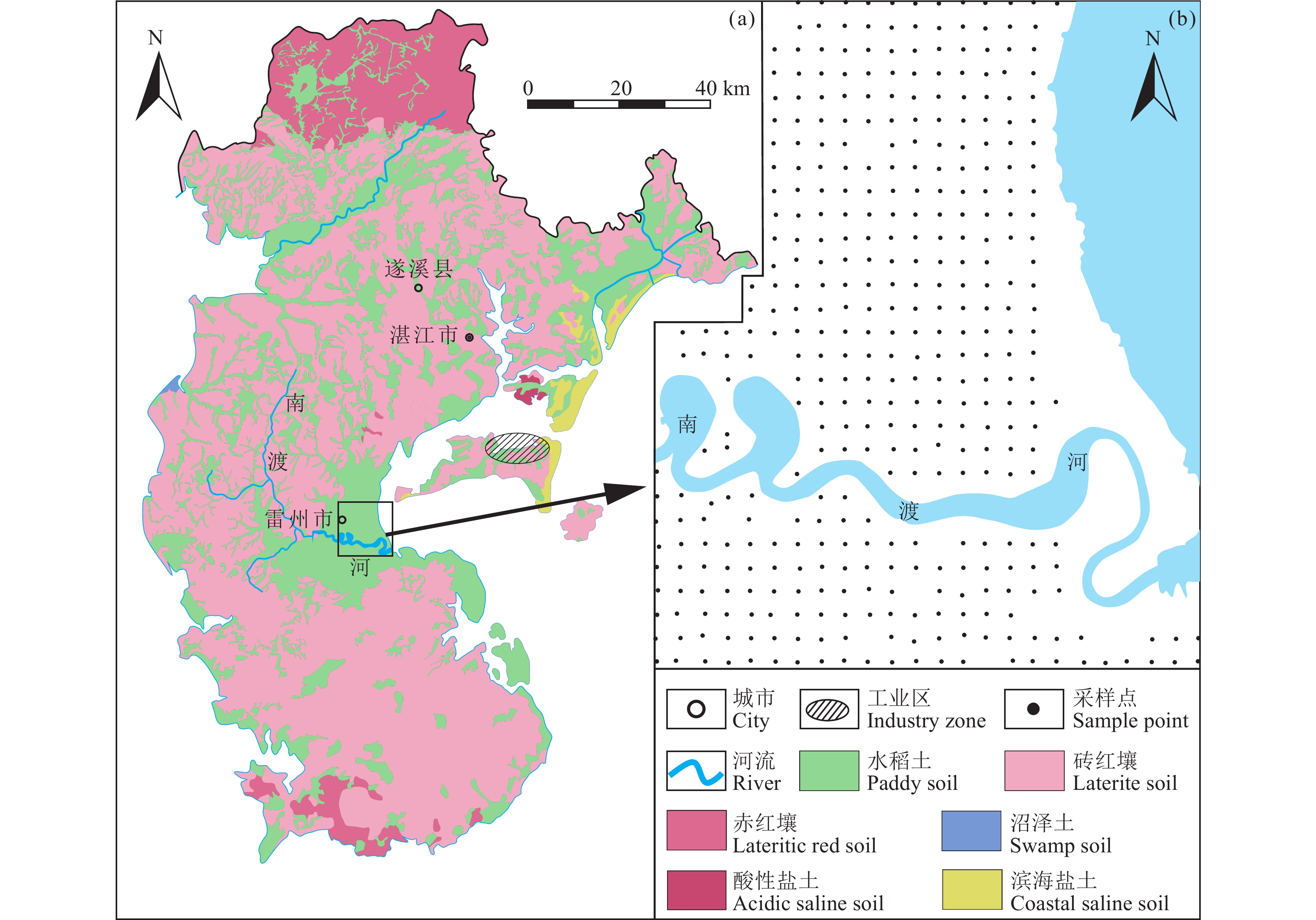
 下载:
下载:
